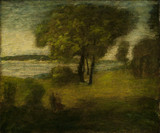Albert Pinkham Ryder was once considered to be among the greatest of American artists. He was a descendant of an old Cape Cod family. He developed eye trouble at an early age, and he did not continue his education beyond grammar school. Ryder began painting by himself before moving with his family to New York at some time after 1868 but before 1871. After initially being rejected, he enrolled in 1871 in the National Academy of Design, where he attended antique and life classes. He exhibited at the National Academy of Design in the spring of 1873 but only intermittently after that. He was featured in a group exhibition with John La Farge and pupils of William M. Hunt shown in the galleries of Cottier and Company about 1875. He exhibited mainly with the progressive Society of American Artists, of which he was a founding member. Ryder made brief visits to London in 1877, 1887, and 1896 and a longer trip with Daniel Cottier (1839-1891) and the sculptor Olin L. Warner (1844-1896) to England, France, Spain, Morocco, Italy, Switzerland, and Holland in 1882. It is hard to tell how greatly he was affected by his European experiences. He is known to have admired the work of Jean-Baptiste-Camille Corot (1796-1875), Adolphe-Joseph-Thomas Monticelli (1824-1886), and Matthijs Maris (1839-1917).
About 1880 Ryder moved to the Benedick Building on Washington Square in New York, where he lived for about the next fifteen years and befriended other artists who had studios there. Around this time his subject matter changed from primarily landscapes to literary, biblical, and operatic themes as well as the highly imaginative nocturnes for which he became best known. The increasingly eccentric and reclusive artist moved in the mid-1890s to rooms at 308 West Fifteenth Street. His creative abilities appear to have declined considerably after 1900, when he seems to have lost inspiration to begin new work. During the early twentieth century his paintings gained wide acceptance among collectors and progressive artists, such as MARSDEN HARTLEY, and forgers. Ten of his paintings were included in the Armory Show of 1913. In 1915 he was hospitalized, and then lived with friends in Elmhurst, Long Island, where he died in 1917.
BIBLIOGRAPHY
Frederic Fairchild Sherman, Albert Pinkham Ryder (New York: Privately printed, 1920), with catalogue of paintings, bibliography, lists of paintings exhibited at the National Academy of Design, the Society of American Artists annuals, and the 1918 Metropolitan Museum of Art’s memorial exhibition § Frederic Newlin Price, Ryder: A Study of Appreciation (New York: Rudge, 1932), with catalogue of paintings § Elizabeth Johns, "Ryder: Some Thoughts on His Subject Matter," Arts 54 (November 1979): 164-71 § Elizabeth Broun, Albert Pinkham Ryder (Washington, D.C.: Smithsonian Institution Press for the National Museum of American Art, 1989), with entries by Eleanor L. Jones and others, reprints of poems by the artist, list of works exhibited 1879-1917, bibliography, catalogue of exhibition at the National Museum of American Art, Smithsonian Institution, Washington, D.C., and Brooklyn Museum, 1990-91 § William Innes Homer and Lloyd Goodrich, Albert Pinkham Ryder: Painter of Dreams (New York: Harry N. Abrams, 1989), with note on technique by Sheldon Keck, reprints of writings by the artist, chronological list of paintings, chronology, bibliography
